PORSCHE PANAMERA 2009 1.G Information Manual
Manufacturer: PORSCHE, Model Year: 2009, Model line: PANAMERA, Model: PORSCHE PANAMERA 2009 1.GPages: 343, PDF Size: 7.96 MB
Page 291 of 343
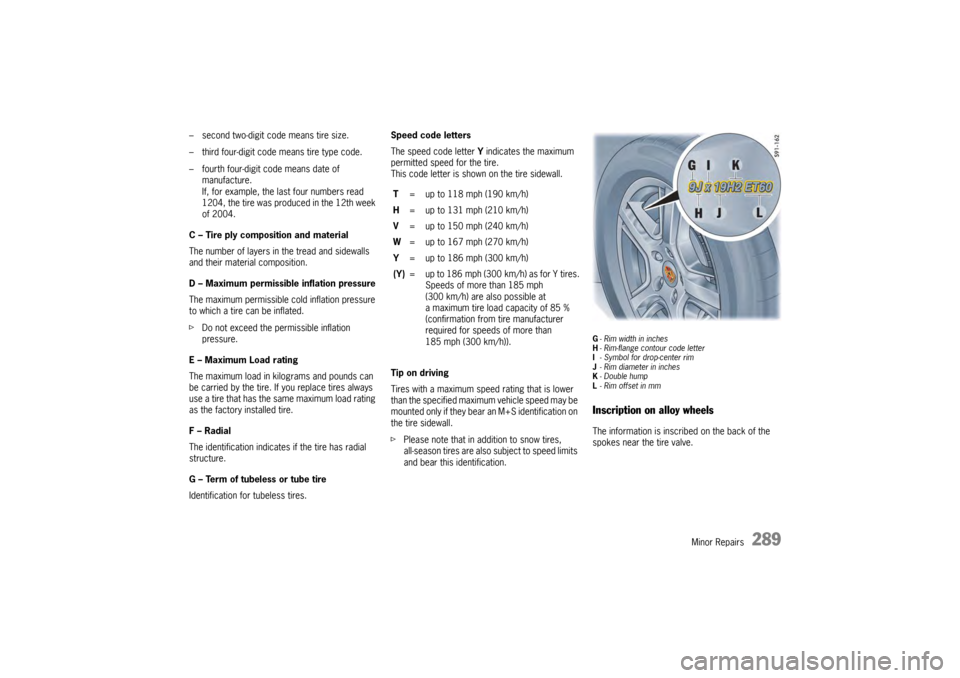
Minor Repairs
289
– second two-digit code means tire size.
– third four-digit code means tire type code.
– fourth four-digit code means date of manufacture.
If, for example, the last four numbers read
1204, the tire was produced in the 12th week
of 2004.
C – Tire ply composition and material
The number of layers in the tread and sidewalls
and their material composition.
D – Maximum permissibl e inflation pressure
The maximum permissible cold inflation pressure
to which a tire can be inflated.
f Do not exceed the permissible inflation
pressure.
E – Maximum Load rating
The maximum load in kilograms and pounds can
be carried by the tire. If you replace tires always
use a tire that has the same maximum load rating
as the factory installed tire.
F – Radial
The identification indicates if the tire has radial
structure.
G – Term of tubeless or tube tire
Identification for tubeless tires. Speed code letters
The speed code letter
Y indicates the maximum
permitted speed for the tire.
This code letter is shown on the tire sidewall.
Tip on driving
Tires with a maximum speed rating that is lower
than the specified maximum vehicle speed may be
mounted only if they bear an M+S identification on
the tire sidewall.
f Please note that in addition to snow tires,
all-season tires are also subject to speed limits
and bear this identification.
G- Rim width in inches
H - Rim-flange contour code letter
I - Symbol for drop-center rim
J - Rim diameter in inches
K -Double hump
L - Rim offset in mmInscription on alloy wheelsThe information is inscribed on the back of the
spokes near the tire valve.
T
= up to 118 mph (190 km/h)
H = up to 131 mph (210 km/h)
V = up to 150 mph (240 km/h)
W = up to 167 mph (270 km/h)
Y = up to 186 mph (300 km/h)
(Y) = up to 186 mph (300 km/h) as for Y tires.
Speeds of more than 185 mph
(300 km/h) are also possible at
a maximum tire load capacity of 85 %
(confirmation from tire manufacturer
required for speeds of more than
185 mph (300 km/h)).
Page 292 of 343
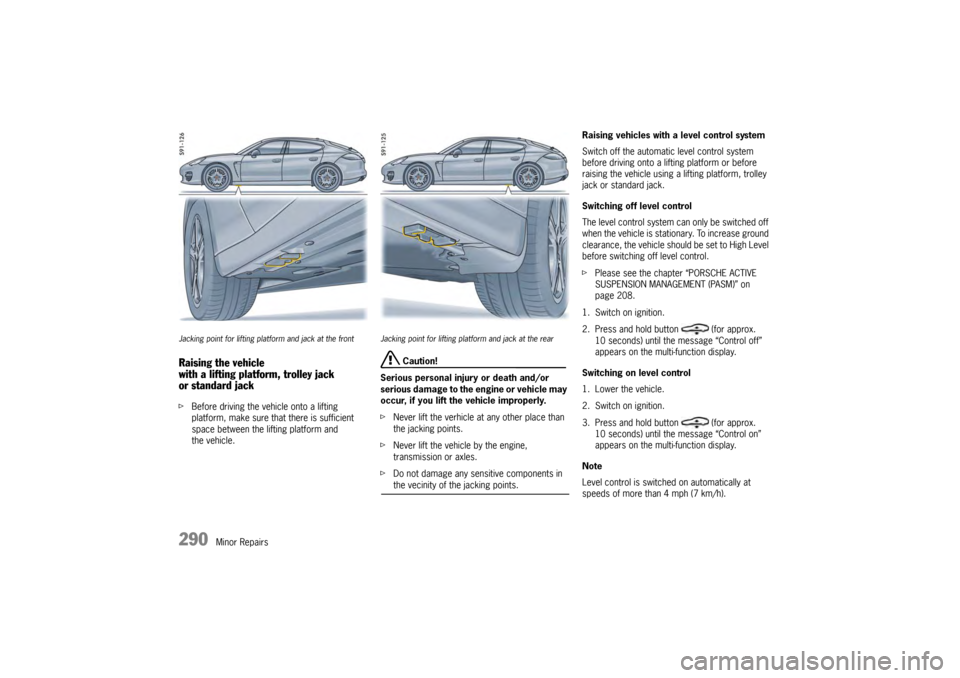
290
Minor Repairs
Jacking point for lifting platform and jack at the frontRaising the vehicle
with a lifting platform, trolley jack
or standard jack fBefore driving the vehicle onto a lifting
platform, make sure that there is sufficient
space between the lifting platform and
the vehicle.
Jacking point for lifting platform and jack at the rear
Caution!
Serious personal injury or death and/or
serious damage to the engine or vehicle may
occur, if you lift the vehicle improperly.
f Never lift the verhicle at any other place than
the jacking points.
f Never lift the vehicle by the engine,
transmission or axles.
f Do not damage any sensitive components in the vecinity of the jacking points. Raising vehicles with a level control system
Switch off the automatic level control system
before driving onto a lifting platform or before
raising the vehicle using a lifting platform, trolley
jack or standard jack.
Switching off level control
The level control system can only be switched off
when the vehicle is stationary. To increase ground
clearance, the vehicle shou
ld be set to High Level
before switching off level control.
f Please see the chapter “PORSCHE ACTIVE
SUSPENSION MANAGEMENT (PASM)” on
page 208.
1. Switch on ignition.
2. Press and hold button (for approx. 10 seconds) until the message “Control off”
appears on the multi-function display.
Switching on level control
1. Lower the vehicle.
2. Switch on ignition.
3. Press and hold button (for approx. 10 seconds) until the message “Control on”
appears on the multi-function display.
Note
Level control is switched on automatically at
speeds of more than 4 mph (7 km/h).
Page 293 of 343

Minor Repairs
291
Changing a wheel
Danger!
Failure to follow these instructions may result
in serious personal inju ry or death to you or
to bystanders.
Before changing the wheel
f If you have a flat tire, move a safe distance off
the road. Turn the emergency flasher on and
use other warning devices to alert other
motorists.
f Do not park your vehicl e where it may contact
dry grass, brush or other flammable materials.
The hot parts of the exhaust system could set
such materials on fire, thereby causing both
property damage and severe or fatal physical
injury.
f Passengers must not be in the vehicle when it
is jacked up.
f Before you change a wheel, be sure the ground
is level and firm. If necessary, use a board
under the jack to ensure that the jack does not
sink into the ground.
f Set the electric parking brake and block the
wheels opposite the flat tire on the other side
of the vehicle.
While operating the jack
f The jack is only to be used for changing a
wheel. Do not use it as a support to work under
the car. f
The car must be jacked up only at the
illustrated jacking points. Lifting at any other
place may damage the vehicle or may result in
personal injury. Never jack the car up by the
body or the bumpers.
f For safety reasons do not use tire inflating
bottles. Do not use co mmercially available
sealant bottles. Use only the tire inflating bottle
located in the luggage compartment.
Note
The tools required for changing a wheel (e.g. jack,
wheel bolt wrench, assembly aids) are not
supplied as standard with the vehicle. Your
authorized Porsche dealer will be pleased to
advise you.
Sequence of operation Warning!
The jack must be used on ly to raise the car
for wheel changing. The jack must never be
used as a support to work underneath the
vehicle. If the jack is accidentally dislodged,
you or bystanders could suffer severe
personal injury.
f Never jack up other ve hicles or other loads
with the jack.
f Always place the car on stable supports if you
have to work under it. When working under the
vehicle, always use safety stands specifically designed for this purpose. f
Please use a suitable knee rest to protect your
clothing against soiling.
1. Activate the electric parking brake and shift into 1st gear or move the PDK selector lever
to position P .
Remove the ignition key or control unit on
vehicles with Porsche Entry & Drive.
2. Switch on the emergency flasher if necessary.
3. Secure the vehicle against rolling away, e.g. by means of wedges at the wheels on the
opposite side.
This is particularly important on slopes.
4. Slightly loosen the wheel bolts on the wheel to be changed.
5. Lift the vehicle only at the specified jacking points.
6. Raise the vehicle until the wheel lifts off the ground.
f Please see the chapter “RAISING THE VEHICLE
WITH A LIFTING PLATFORM, TROLLEY JACK
OR STANDARD JACK” on page 290.
7. Remove 1 or 2 wheel bolts (see corresponding figure).
Page 294 of 343
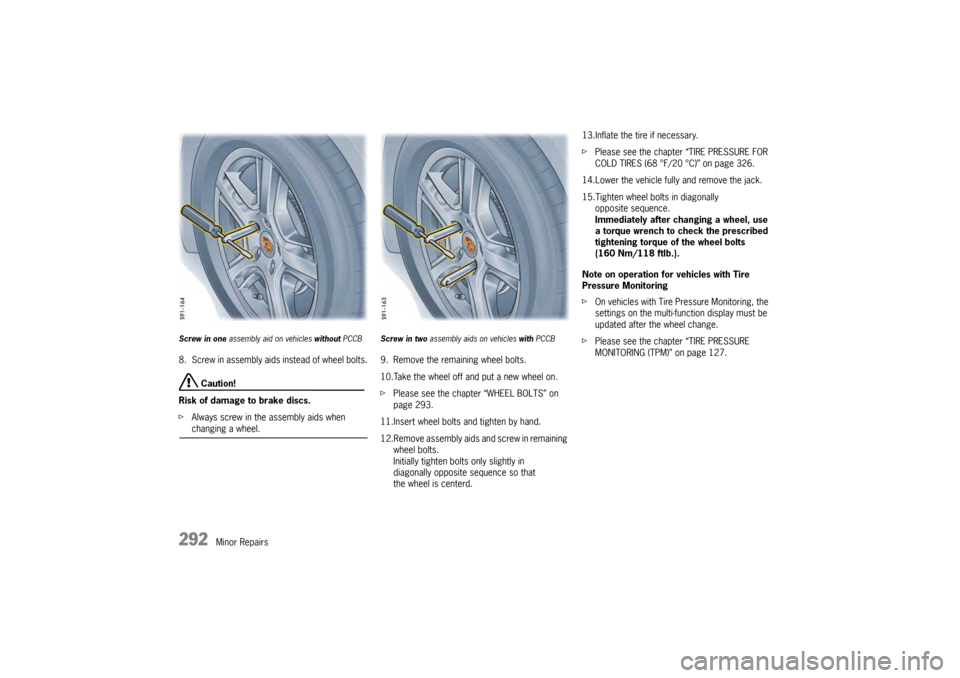
292
Minor Repairs
Screw in one assembly aid on vehicles without PCCB8. Screw in assembly aids instead of wheel bolts.
Caution!
Risk of damage to brake discs.
f Always screw in the assembly aids when changing a wheel.
Screw in two assembly aids on vehicles with PCCB9. Remove the remaining wheel bolts.
10.Take the wheel off and put a new wheel on.
fPlease see the chapter “WHEEL BOLTS” on
page 293.
11.Insert wheel bolts and tighten by hand.
12.Remove assembly aids and screw in remaining wheel bolts.
Initially tighten bolts only slightly in
diagonally opposite sequence so that
the wheel is centerd. 13.Inflate the tire if necessary.
f
Please see the chapter “TIRE PRESSURE FOR
COLD TIRES (68 °F/20 °C)” on page 326.
14.Lower the vehicle fully and remove the jack.
15.Tighten wheel bolts in diagonally opposite sequence.
Immediately after changing a wheel, use
a torque wrench to check the prescribed
tightening torque of the wheel bolts
(160 Nm/118 ftlb.).
Note on operation for vehicles with Tire
Pressure Monitoring
f On vehicles with Tire Pressure Monitoring, the
settings on the multi-function display must be
updated after the wheel change.
f Please see the chapter “TIRE PRESSURE
MONITORING (TPM)” on page 127.
Page 295 of 343
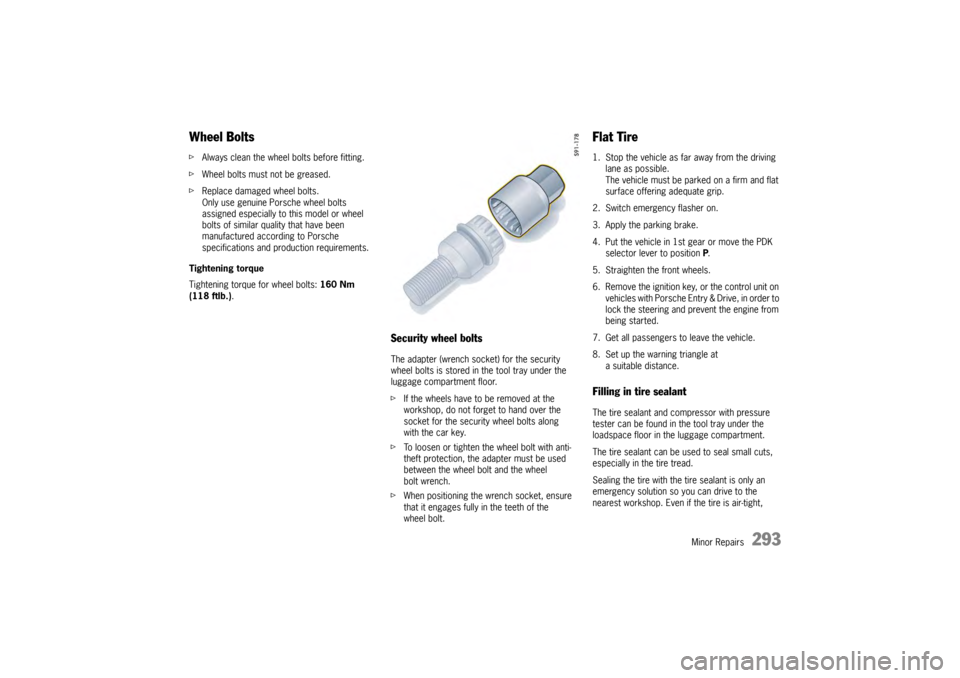
Minor Repairs
293
Wheel Bolts fAlways clean the wheel bolts before fitting.
f Wheel bolts must not be greased.
f Replace damaged wheel bolts.
Only use genuine Porsche wheel bolts
assigned especially to this model or wheel
bolts of similar quality that have been
manufactured according to Porsche
specifications and production requirements.
Tightening torque
Tightening torque for wheel bolts: 160 Nm
(118 ftlb.) .
Security wheel boltsThe adapter (wrench socket) for the security
wheel bolts is stored in the tool tray under the
luggage compartment floor.
fIf the wheels have to be removed at the
workshop, do not forget to hand over the
socket for the security wheel bolts along
with the car key.
f To loosen or tighten the wheel bolt with anti-
theft protection, the adapter must be used
between the wheel bolt and the wheel
bolt wrench.
f When positioning the wrench socket, ensure
that it engages fully in the teeth of the
wheel bolt.
Flat Tire 1. Stop the vehicle as far away from the driving lane as possible.
The vehicle must be parked on a firm and flat
surface offering adequate grip.
2. Switch emergency flasher on.
3. Apply the parking brake.
4. Put the vehicle in 1st gear or move the PDK selector lever to position P.
5. Straighten the front wheels.
6. Remove the ignition key, or the control unit on vehicles with Porsche Entry & Drive, in order to
lock the steering and pr event the engine from
being started.
7. Get all passengers to leave the vehicle.
8. Set up the warning triangle at a suitable distance.Filling in tire sealantThe tire sealant and compressor with pressure
tester can be found in the tool tray under the
loadspace floor in the luggage compartment.
The tire sealant can be used to seal small cuts,
especially in the tire tread.
Sealing the tire with the tire sealant is only an
emergency solution so you can drive to the
nearest workshop. Even if the tire is air-tight,
Page 296 of 343
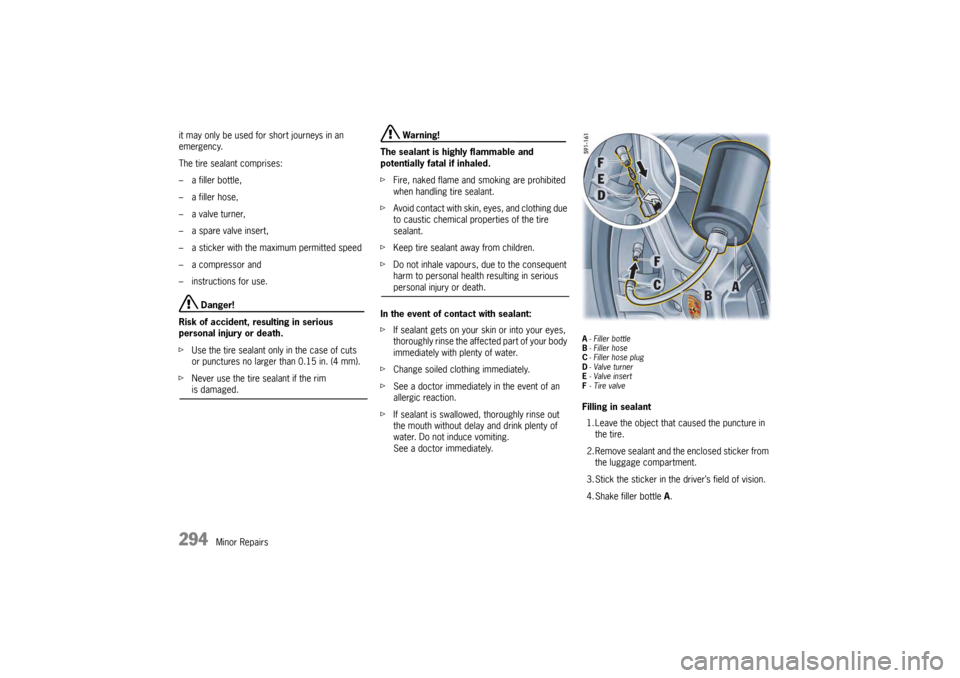
294
Minor Repairs
it may only be used for short journeys in an
emergency.
The tire sealant comprises:
– a filler bottle,
– a filler hose,
– a valve turner,
– a spare valve insert,
– a sticker with the maximum permitted speed
– a compressor and
– instructions for use.
Danger!
Risk of accident, resulting in serious
personal injury or death.
f Use the tire sealant only in the case of cuts
or punctures no larger than 0.15 in. (4 mm).
f Never use the tire sealant if the rim is damaged.
Warning!
The sealant is highly flammable and
potentially fatal if inhaled.
f Fire, naked flame and smoking are prohibited
when handling tire sealant.
f Avoid contact with skin, eyes, and clothing due
to caustic chemical properties of the tire
sealant.
f Keep tire sealant away from children.
f Do not inhale vapours, due to the consequent
harm to personal health resulting in serious personal injury or death.
In the event of contact with sealant:
f If sealant gets on your skin or into your eyes,
thoroughly rinse the affected part of your body
immediately with plenty of water.
f Change soiled clothing immediately.
f See a doctor immediately in the event of an
allergic reaction.
f If sealant is swallowed, thoroughly rinse out
the mouth without delay and drink plenty of
water. Do not in duce vomiting.
See a doctor immediately.
A - Filler bottle
B - Filler hose
C - Filler hose plug
D -Valve turner
E -Valve insert
F - Tire valveFilling in sealant
1. Leave the object that caused the puncture in the tire.
2. Remove sealant and the enclosed sticker from the luggage compartment.
3. Stick the sticker in the driver’s field of vision.
4. Shake filler bottle A .
Page 297 of 343

Minor Repairs
295
5. Screw filler hose B onto the filler bottle.The filler bottle is now open.
6. Unscrew valve cap from the tire valve F.
7. Remove valve insert E from the tire valve with
valve turner D.
Keep the valve insert in a clean, dry place.
8. Remove plug C from the filler hose B.
9. Push filler hose onto the tire valve.
10.Hold the filler bottle higher than the level of the
tire valve and squeeze it forcefully until the
bottle is completely emptied into the tire.
11.Pull filler hose off the tire valve.
12.Twist the valve insert firmly into the tire valve using the valve turner.
13.Connect the compressor to a vehicle plug socket and inflate the tire to at least 37 psi
(2.5 bar).
If this tire pressure cannot be reached, the tire
is too severely damaged. You must not
continue driving with this tire.
14.Screw valve cap onto the tire valve. 15.After driving for approx. 10 minutes, check the
tire pressure.
If the tire pressure is less than 22 psi (1.5 bar),
do not continue driving.
If a value of more than 22 psi (1.5 bar) is
indicated, correct the pressure to the
prescribed value.
f Please see the chapter “TIRE PRESSURE FOR
COLD TIRES (68 °F/20 °C)” on page 326.
16.Please contact a qualified specialist workshop. We recommend that you have an authorized
Porsche dealer to do this work as they have
trained workshop personnel and the necessary
parts and tools.
f Please also make sure to follow the separate
instructions for use for the tire sealant.
Note on operation for vehicles with Tire
Pressure Monitoring
f The settings for Tire Pressure Monitoring must
be updated on the multi-function display after
filling the tire with sealant.
f Please see the chapter “OVERVIEW OF
WARNING MESSAGES” on page 152. Care instructions
After drying, any sealan
t that emerges can be
peeled off like a film.
Warning!
Risk of accidents, resulting in serious
personal injury or death.
f Have the tire replaced by a specialist
workshop as soon as possible.
Inform the specialist workshop that the tire
contains sealant.
f Avoid hard acceleration and high cornering
speeds.
f Observe the maximum speed of 50 mph
(80 km/h).
f Always observe the safety and operating
instructions, which can be found in the
separate operating instructions for the sealant and on the compressor.
Page 298 of 343
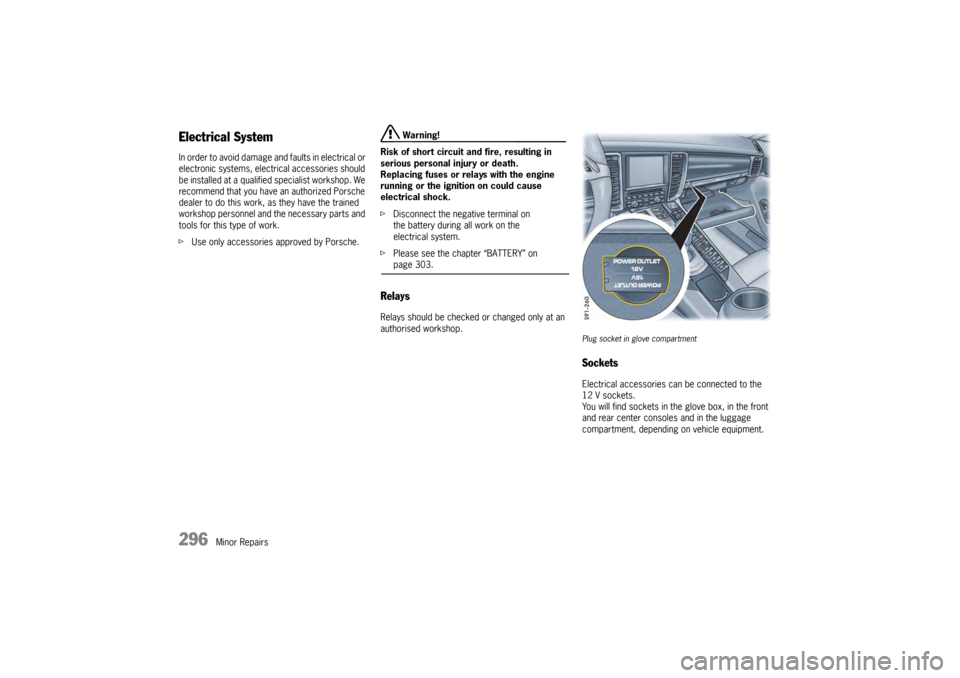
296
Minor Repairs
Electrical SystemIn order to avoid damage and faults in electrical or
electronic systems, electrical accessories should
be installed at a qualified specialist workshop. We
recommend that you have an authorized Porsche
dealer to do this work, as they have the trained
workshop personnel and the necessary parts and
tools for this type of work.
fUse only accessories approved by Porsche.
Warning!
Risk of short circuit and fire, resulting in
serious personal injury or death.
Replacing fuses or relays with the engine
running or the ignition on could cause
electrical shock.
f Disconnect the negative terminal on
the battery during all work on the
electrical system.
f Please see the chapter “BATTERY” on page 303.
RelaysRelays should be checked or changed only at an
authorised workshop.
Plug socket in glove compartmentSocketsElectrical accessories can be connected to the
12 V sockets.
You will find sockets in the glove box, in the front
and rear center consoles and in the luggage
compartment, depending on vehicle equipment.
Page 299 of 343
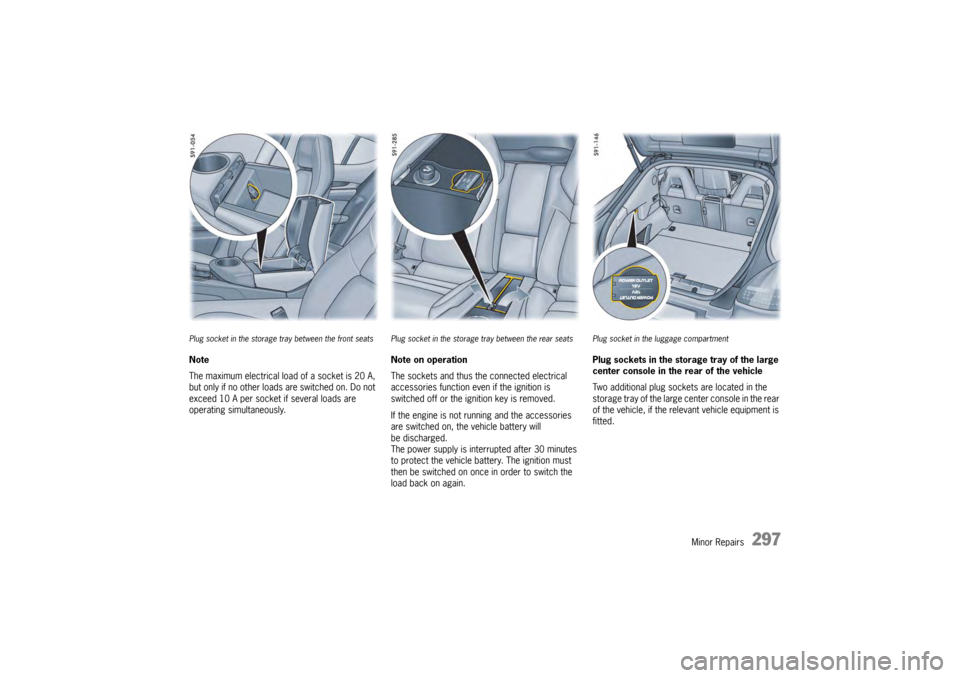
Minor Repairs
297
Plug socket in the storage tray between the front seatsNote
The maximum electrical load of a socket is 20 A,
but only if no other loads are switched on. Do not
exceed 10 A per socket if several loads are
operating simultaneously.
Plug socket in the storage tray between the rear seatsNote on operation
The sockets and thus the connected electrical
accessories function even if the ignition is
switched off or the ignition key is removed.
If the engine is not running and the accessories
are switched on, the vehicle battery will
be discharged.
The power supply is interrupted after 30 minutes
to protect the vehicle battery. The ignition must
then be switched on once in order to switch the
load back on again.
Plug socket in the luggage compartmentPlug sockets in the storage tray of the large
center console in the rear of the vehicle
Two additional plug sockets are located in the
storage tray of the large center console in the rear
of the vehicle, if the re levant vehicle equipment is
fitted.
Page 300 of 343

298
Minor Repairs
Changing fusesIn order to prevent damage to the electrical
system due to short circuits and overloads,
the individual circuits are protected by fuses.
One fuse box is located in the luggage
compartment. Two additional fuse boxes are
located in the outer en ds of the dashboard.
1. Switch off the load with the defective fuse.
2. Open the fuse box cover.
3. Remove the corresponding fuse from its slot using the plastic gripper D in order to check it.
A blown fuse can be iden tified by the melted
metal strip.
4. Replace only with fuses of the same rating. We recommend that you use genuine Porsche
fuses for replacement.
Note
f If a fuse blows repeatedly:
Please contact a qualif ied specialist workshop.
We recommend that you have an authorized
Porsche dealer to do this work as they have
trained workshop personnel and the necessary
parts and tools.
A - Fuse carrier
B - Fuse carrier
C - Relay carrierOpening fuse box and relay box cover in
luggage compartment
f Open the luggage compartment floor and
remove the tool storage box.
D- Plastic gripperOpening fuse box cover at the left and right
of the dashboard
1. Carefully lever off the plastic cover with
a screwdriver (arrow ) and remove it.
The positions of the fuses are shown on the
inside of the cover.
2. Carefully remove the fuses using the plastic gripper D.
f Spare fuses can be found in both fuse box
covers (left: 7.5 and 10 A; right: 20 and 25 A).